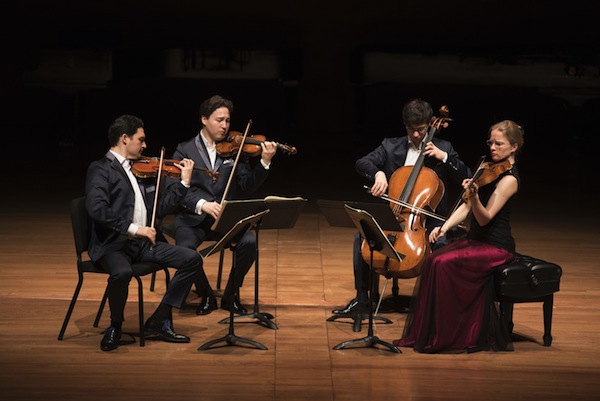American works come off best in ’20’s program from Chamber Music Society

The Schumann Quartet performed music of Copland and Janáček in the Chamber Music Society of Lincoln Center concert on Sunday. Photo: Tristan Cook
The 1920s for classical music was a decade when several styles were prominent simultaneously. Romanticism was still strong and was growing a branch of expressionism; the atonality of the Second Viennese School was on the rise, as was Stravinsky’s neo-Classicism; and even though jazz had yet to mature it was already influencing composers and musicians.
The Chamber Music Society of Lincoln Center took a quick look into that past Sunday afternoon in Alice Tully Hall with a program they called “The Roaring Twenties.” There was some distinctive music of the era from Copland and Gershwin, and two surprise selections by Leoš Janáček and Erich Wolfgang Korngold.
Just as WWI was a precursor to WWII, so were the ‘20s a foreshadowing of things to come 20 years later, at least for America. Copland’s “Lento Molto” from Two Pieces for String Quartet and Gershwin’s two-piano version of An American in Paris were natural representatives of the rise of American cultural power. In an interesting juxtaposition of old worlds and new, those were flanked by Janáček’s Quartet No. 2 for Strings, “Intimate Letters,” and a rarity from Korngold, the Suite for Piano Left Hand, Two Violins, and Cello.
Janáček’s swan song came from the mind of a man carrying on an unstable infatuation with a much younger, married woman, whom he could never have. “Intimate Letters” is fueled by Janacek’s life experience, and full of beautiful moments, odd moments, and parts meant to slice the heart.
The Schumann Quartet (named after brothers violinists Erik and Ken, and cellist Mark Schumann, with violist Liisa Randalu) played the quartet works Sunday. Like so many other young, polished string quartets these days, the Schumanns have a full, shining sound, and abundant technical resources.
What they didn’t have was a feeling for the music, and Janáček’s quartet came off as flat and dull. The playing, especially in the first movement, was stolid and serious in an over-reverent way, as if each note should be presented as a lecture meant to argue for the greatness of the music. One felt this was a product of the quartet’s lack of seasoning–that the kind of experiences they are yet to have, the kind Frank Sinatra used to sing about, were required to grasp the bittersweet vein in the music.
The Schumanns were vastly better in the “Lento molto” with Copland’s objective style an ideal match for their sensibilities. Here, their deliberateness was a fine way to put together Copland’s sturdy and modern musical architecture.
Pianists Juho Pohjonen and Wu Qian finished the first half with a wonderful performance of An American in Paris. Pohjonen has already impressed at CMS with his scintillating touch, and that was well-paired with Qian’s heavier, rounder tone. Their mutual agility meant that the sound of the two pianos was absolutely clear, every single note with a sculpted articulation.
Even better was their swagger, their great handle on the music’s rhythms, the back and forth banter across riffs, the jaunty phrasing. Underneath was the sense of fun they brought to the music, the idea that something meant to entertain can be seriously great while doing just that.
Korngold’s piece, dated 1930 and so coming just under the 1920‘s wire, pulled together several unique threads from that era. This was commissioned by pianist Paul Wittgenstein, less famous than his brother Ludwig, but deeply important in that he lost his right hand in WWI, kept playing, and eventually commissioned Ravel’s Concerto for the Left Hand, Britten’s Diversions, and this ungainly quartet from Korngold.
The composer is recognized for his great film scores. But the turgid piano cadenza that began the first, Präludium movement, was a nearly comical picture of an artist trying to prove his gravity through his demeanor rather than his ideas.
Much of the first movement was dramatic gestures and assertions. The committed energy of the players—Qian, violinists Danbi Um and Sean Lee, and cellist Mihai Marica—rather than making a case for the music, merely made it seem overwrought and exhausting.
There were virtues, a Walzer movement that was full of natural charm, and an imaginative Rondo finale. Other than the film scores, Korngold is known for a good Violin Concerto, and occasionally one discusses the issue of why he was not a more prominent composer. This Suite explains why.
Violinist Ani Kavafian and pianist Anne-Marie McDermott performed The Art of the Recital, 7:30 p.m. March Thursday, in the Rose Studio. chambermusicsociety.org







Posted Mar 19, 2018 at 6:08 am by zwirchi
Thanks for the review, Jom!